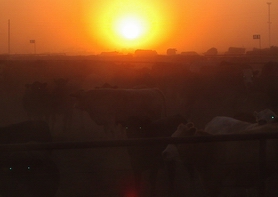
Ammonia and methane emissions from a feedlot, 2003
- Objective: estimate the fluxes of methane and ammonia from a feedlot (47,000 cattle)
- Method:
- lasers measure the line-average concentration of the gas over a pathlength of 100 to 500 metres, downwind from the source
- Sensors over the feedlot and elsewhere measure the wind direction and speed, and other micrometeorological information
- These signals are formed into 15 minute averages for the line average concentration C.
- A "random flight" model (also known as a "backward Lagrangian stochastic" model) computes the random paths of thousands of air parcels that arrive in the laser beam, having travelled over the feedlot, and determines the emission rate necessary to explain the measured concentration. The trajectory model is implemented in a GIS (Geographical Information System) package called WindTraX ( link to Brian Crenna's information page on WindTraX). Here the main screen of WindTraX shows the feedlot pens (in yellow), a run-off collection pond (in green), a laser situated downwind from the run-off pond, and a cloud of "touchdowns," ie. points at which air parcels, travelling towards the laser and eventually passing through the laser beam, have "touched down" on the sources. Touchdowns on the pens or the pond are marked in red, while touchdowns outside the sources are grey.
- Flesch, T.K., J.D. Wilson, L.A. Harper, R.W. Todd and N.A. Cole, 2007: Monitoring feedlot emissions with the inverse dispersion technique. Agricultural and Forest Meteorology, 144, 139-155.
Back to John D. Wilson home page.
Back to the Earth & Atmospheric Sciences home page.
Last Modified: 25 Sept. 2008
